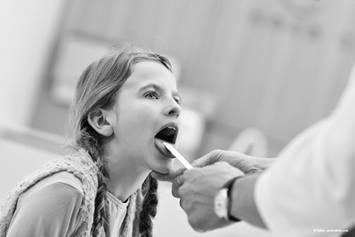Strep Throat (Bacterial)
Strep throat is a bacterial infection that causes sore throat, fever, headache and stomach pain. It is contagious and can be treated with antibiotics.
What Is Strep Throat?
Two different germs cause sore throats – viruses and bacteria. When a sore throat comes on fast, it may be caused by the bacteria streptococci (strep-tuh-kaak-sai), or strep. Strep throat is most common in school-age children, but anyone can get it.- Strep throat can be spread to others. It is
contagious.
- Strep germs hang out in the nose and throat. When the infected person coughs, sneezes, or talks, the germs go into the air. They are then breathed in by others.
- The germs can also land on things and be picked up by touching them. ·
- Strep is easy to treat.
- Untreated strep can harm the body. If the body overreacts to the bacteria, it can lead to a disease called rheumatic fever. Rheumatic fever can cause painful and swollen joints, a specific type of rash, kidney damage, or harm the heart.
- Start antibiotic medicine as soon as possible to prevent harm to the body.
- People who test positive for strep but show no
symptoms are called carriers. Carriers:
- Usually don’t take antibiotics. If your child gets a sore throat and you know they’re a strep carrier, the doctor or health care provider will treat their illness like a virus.
- Are less likely to get complications or spread the strep to others.
- Will always have positive throat cultures even after taking antibiotics. As many as 1 in 5 children are strep carriers.
What Are Signs and Symptoms of Strep Throat?
A child with strep throat may any of these symptoms:
- Red, sore throat
- Fever
- White spots on back of throat, tonsils, or tongue
- Swollen, tender neck glands
- Bright red tongue
- Trouble swallowing
- Tiny red spots on roof of mouth
- Headache, fussiness
- Red, sandpaper-like rash on body (scarlet fever)
- Sleeping more than usual
- Stomachache, poor appetite, nausea or vomiting, especially in younger children
When a child has a cough, hoarseness, red eyes and runny nose, it may be due to a virus, the flu or a different illness rather than strep.
How Is Strep Throat Diagnosed?
The doctor or health care provider will examine your child, ask about signs and symptoms, and test for strep.
- There are 2 tests
used to diagnose strep throat. Both use the same soft swab. The doctor or
health care provider will brush 1 or 2 swabs over the back of the throat. Your
child may gag a little.
- A rapid strep test (rapid antigen test) – It takes up to 30 minutes to get the results of a rapid strep test. You will stay until you get the results.
- A throat culture – Sometimes only this test is done. A swab is sent to the lab for testing. It takes 1 to 2 days to get the results. The lab will notify your child’s doctor or health care provider, who will then let you know the results.
- A positive rapid strep test or positive throat culture means that your child has strep throat caused by the harmful bacteria.
How Is Strep Throat Treated?
Treatment with Antibiotics
- If your child has a positive strep test, they will start to take antibiotic medicine right away, by mouth or by injection.
- Tell your child’s doctor or health care provider if they are allergic to penicillin. If they are, they will need to take a different antibiotic.
- Your child must take all medicine as prescribed, without stopping, even if they start to feel better. Stopping too early, taking too much, or missing doses can cause antibiotic resistance. Resistance means that the germs will be very hard to kill. Sometimes the infection can’t be treated at all.
- Antibiotics can have side effects like diarrhea or rash.
- Your child should start feeling better within 1 to 2 days.
How to Care For Your Child
There are things you can do to help your child feel better.
- Give them lots of liquids, like water, Pedialyte, diluted apple juice, or popsicles. Give small amounts of liquid often.
- Give soft foods that are easy to swallow, like applesauce, mashed potatoes, hot cereal, or eggs. Your child may not want to eat much if it hurts to swallow.
- To soothe a sore throat, offer:
- For children over age 1, give warm fluids like water, herbal tea with honey, or diluted apple juice. Do not give honey to children under age 1. For some children, cold fluids or popsicles can be soothing.
- For children over age 4, give throat or cough lozenges or use throat sprays. Read the label to know the right dose for your child. Do not use throat sprays that contain benzocaine, as this could cause a drug reaction.
- For children over age 6 who are able to gargle without swallowing, mix ½ teaspoon of table salt in 8 ounces of warm water. Have them swish and gargle the mixture 2 to 3 times a day for the next few days. Do not let your child swallow the salt water; have them spit it out.
- For a fever or throat pain, give acetaminophen (Tylenol®) or ibuprofen (Advil® or Motrin®) as directed. Read the label to know the right dose for your child. Do not give aspirin or products that contain aspirin.
How to Protect Others
- Keep your child away from others for 12 hours after they start antibiotics.
- Good hand washing is very important! Clean your hands and your child’s hands often with soap and water. Wash for 15 to 20 seconds, or the time it takes to sing "Happy Birthday." If soap and water are not available, an alcohol-based hand sanitizer that contains at least 60% alcohol may be used. Rub hands until dry Have your child cover their mouth when coughing or sneezing. Throw used tissues away right away.
- Do not share drinking cups or eating utensils.
- If anyone in the family gets a sore throat, they should be checked by their doctor or health care provider for strep.
- Tell your child’s school nurse and teacher if they have strep throat. The school needs to know so they can tell other parents to watch for symptoms in their children.
- Your child should stay home from school or childcare until they have taken antibiotic medicine for 12 hours and have no fever.
When to Call the Doctor or Health Care Provider
Call your child’s doctor or health care provider if they have started taking antibiotics and they:
- Develop a rash or diarrhea.
- Have a sore throat that lasts more than 3 days, starts drooling, cannot talk, or voice becomes muffled.
- Can’t eat or drink or show signs of being dried out (dehydration). Signs of dehydration:
- Does not pee (urinate)
- Newborn (0 to 4 months of age) - has less than 6 wet diapers in a day
- Child (4 months or older) - has less than 3 wet diapers in a day or pees less than 3 times a day
- Dry, sticky mouth
- Hard or fast breathing
- Urine is very dark
- No tears when crying
- Sunken-looking eyes
- Soft spot on baby's head is flat, sunken, or pulls in
- Bellyache (abdominal pain) that will not go away
- Hard to wake up (lethargic), acts confused or does not know what they're doing
- Does not pee (urinate)
- Start drooling, cannot talk, or voice becomes muffled.
- Have a fever. Use a digital thermometer and was it after each use.
- Younger than 3 months of age - 100.4° Fahrenheit (F) or 38° Celsius (C) or above
- Older than 3 months of age:
- 104° F (40° C) or above
- Above 102° F (38.9° C) for more than 2 days or it keeps coming back
- Treated to bring their fever down, but it hasn’t worked
- Any age - has a fever and:
- An unusual rash.
- Has been in a very hot place, such as an overheated car.
- Looks very ill, is fussy, or very drowsy.
- Is not eating or drinking and shows signs of dehydration - dry or sticky mouth, sunken eyes, dark urine, dry diapers, or not urinating.
- Has a stiff neck, a bad headache, very sore throat, a painful stomachache, vomiting, or diarrhea.
- Has immune system problems that make them more likely to get sick, such as sickle cell disease or cancer, or takes medicine that weakens the immune system.
Helping Hands Patient Education Materials
Written and illustrated by medical, nursing and allied health professionals at Nationwide Children's Hospital, Helping Hand instructions are intended as a supplement to verbal instructions provided by a medical professional. The information is periodically reviewed and revised to reflect our current practice. However, Nationwide Children's Hospital is not responsible for any consequences resulting from the use or misuse of the information in the Helping Hands.
HH-I-122 | ©1989, revised 8/22, Nationwide Children’s Hospital


